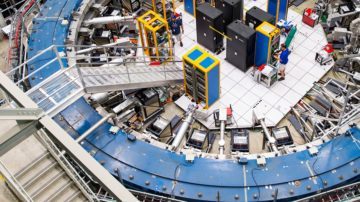by David Kordahl

If you follow science news, there’s a good chance that you’ve recently heard about Muon g-2 (pronounced “mew-awhn gee minus two”), an experiment whose preliminary results were announced to media fanfare and general excitement. The experiment’s most recent iteration is going on at Fermilab, the physics facility outside Batavia, Illinois, but it continues an experiment that wrapped at Brookhaven National Lab, over in New York, back in the mid-2000s. The experimental appratus, a magnetic ring some 50 feet across, traveled from one lab to the other in a single piece—the pictures of this are impressive—all so the anomalous magnetic dipole moment of the muon could be measured with an unprecedented precision.
The vocabulary itself here was a challenge for headline writers. The main focus was about how this measurement of … whatever it was … would be revolutionary. “A Tiny Particle’s Wobble Could Upend the Known Laws of Physics,” went a headline at the New York Times. “Muon g-2 Experiment at Fermilab Finds Hint of New Particles,” wrote Quanta. An explainer comic from the American Physical Society stressed how “new discoveries are on the horizon,” and Résonaances, a blog widely read by physicists, noted the deluge of new g-2 papers, and found hints that might “open a new experimental era that is almost too beautiful to imagine.”
I have no argument with any of these articles, but they are mainly concerned with narrative building, with explaining how the new measurements fit into an ongoing quest to go beyond the standard model, the “standard model” being a bland summary term for all fundamental physics except for gravity. (Gravity gets its own fundamental theory—viz., general relativity.) But while these articles ably summarized why physicists care about these measurements, they contained hardly any physics, hardly any material of the sort that, after reading, lets you understand what’s going on out there, beyond mere social descriptions. Read more »
